- Administrator
- Albums and Singles
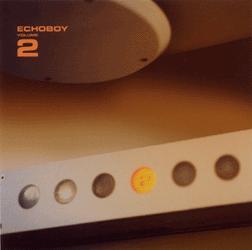 Talk about variety, thesecond Echoboy album of the year once again follows a seeminglymulti-genre'd blueprint as Volume 1. Richard Warren, who goes by thename of Echoboy has gathered another ecclectic collection of nineself-recorded self-produced delves into audio experimental popinfluenced rock tunes. Whether it echoes early 80s electro pop a'laPeter Schilling's "Major Tom" or 90s analogue synth retro, Warren'senergy is fiery and relentless, his talent as a songwriter and musicianis undying. Some songs carry a feverish pulse, with a utilization ofguitars and vintage keyboard sounds not entirely unlike good oldSuicide or Trans Am. When the slower paced tunes creep through thespeakers, the music is never less saturated. The usage of variousorganic drums with electronic drum machines, guitar filters, bass linesand special effects . Echoboy's loved by critics and adored by collegeDJs all over the world, I assume because it seems like the guy's arabid music fan like the rest of us, and hasn't decided to make a'band' to only focus on one style. If I only had one complaint aboutEchoboy, it would be that this guy has way too many limited editionsingles and EPs of which many tracks will probably be lost, never tosee the light of day again. Brilliant asshole.
Talk about variety, thesecond Echoboy album of the year once again follows a seeminglymulti-genre'd blueprint as Volume 1. Richard Warren, who goes by thename of Echoboy has gathered another ecclectic collection of nineself-recorded self-produced delves into audio experimental popinfluenced rock tunes. Whether it echoes early 80s electro pop a'laPeter Schilling's "Major Tom" or 90s analogue synth retro, Warren'senergy is fiery and relentless, his talent as a songwriter and musicianis undying. Some songs carry a feverish pulse, with a utilization ofguitars and vintage keyboard sounds not entirely unlike good oldSuicide or Trans Am. When the slower paced tunes creep through thespeakers, the music is never less saturated. The usage of variousorganic drums with electronic drum machines, guitar filters, bass linesand special effects . Echoboy's loved by critics and adored by collegeDJs all over the world, I assume because it seems like the guy's arabid music fan like the rest of us, and hasn't decided to make a'band' to only focus on one style. If I only had one complaint aboutEchoboy, it would be that this guy has way too many limited editionsingles and EPs of which many tracks will probably be lost, never tosee the light of day again. Brilliant asshole.samples:
Read More
- Administrator
- Albums and Singles
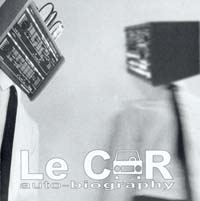 With a fondness of vintage analogue keyboards and rockin tunes is this defunct (?) Detroit duo. Herein lies 23 tracks recorded between 1996 and 1998, pulled from various out of print 12" and EP releases. Le Car's automobile has been retrofitted with analogue keyboards, but it drives quite smoothly and is exciting to show off.
With a fondness of vintage analogue keyboards and rockin tunes is this defunct (?) Detroit duo. Herein lies 23 tracks recorded between 1996 and 1998, pulled from various out of print 12" and EP releases. Le Car's automobile has been retrofitted with analogue keyboards, but it drives quite smoothly and is exciting to show off.
Pounding beats and catchy melodies throughout the disc make it entertaining, enjoyable and a true hit with your friends. With songs like "Flame Job," and "Malice" visions of Human League and Heaven 17 dance in the head while tracks like "Audiofile Five" echo early melodic 808 State, undersaturated in effects and gear however. 'Auto Biography' serves as a great collection as well as an excellent reference point, as both members have jumped into other moving vehicles, Adult and Perspect.
samples:
- Flame Job
- Audiofile Five
- Motorway Sparks (GD Luxxe mix)
Read More
- Carl Thien
- Albums and Singles
 This is the first release of DirkDresselhaus (schneider TM) since his 'Moist' full length was licenced for UK release by Mutefrom Germany's City Slang Records. He has made this 6 song mini-album in collaboration withKPT.michi.gan aka Michael Beckett (who usually joins schneiderTM as part of his live band),and Japanese artist Hanayo http://www.hanayo.com/ (her site has a lot of fun things tolook at). Hanayo is a very interesting person based on a look around her site. She provides thevocals (another first on any schneider TM release) on 2 songs" "Onnanoko" and "The Light3000", which is a cover of The Smiths song "There Is A Light That Never Goes Out". Prettyneat, huh? In fact it is. I loved the Moist album and I like this a lot too. The first song on eachside are busy instrumentals, the second song on each side are quiet instrumentals, and the lastsong on each side are the vocal tracks.
This is the first release of DirkDresselhaus (schneider TM) since his 'Moist' full length was licenced for UK release by Mutefrom Germany's City Slang Records. He has made this 6 song mini-album in collaboration withKPT.michi.gan aka Michael Beckett (who usually joins schneiderTM as part of his live band),and Japanese artist Hanayo http://www.hanayo.com/ (her site has a lot of fun things tolook at). Hanayo is a very interesting person based on a look around her site. She provides thevocals (another first on any schneider TM release) on 2 songs" "Onnanoko" and "The Light3000", which is a cover of The Smiths song "There Is A Light That Never Goes Out". Prettyneat, huh? In fact it is. I loved the Moist album and I like this a lot too. The first song on eachside are busy instrumentals, the second song on each side are quiet instrumentals, and the lastsong on each side are the vocal tracks.Read More
- Carl Thien
- Albums and Singles
 "Part of the 'Atom Series', a series of limited vinyl only releases by AtomicRecordings favourite new artists from around the globe" informs the website. Atomic Recordingsis a Belgium label, The Remote Viewer is a Leeds UK band formed by 2 ex-members of Hoodwho also used to record as The Famous Boyfriend. The music is 4 instrumentals that areelectronic and slightly somber in tone, kind of like an early morning/late night ISAN. AtomicRecordings was also associated with 'In The Fishtank', the series that released the collaborationbetween The Ex & Tortoise, and a Guvner disc as well. 'In The Fishtank' captures exclusiveAmsterdam recording sessions by touring bands. 'In The Fishtank' is run by their dutchdistribution company 'De Konkurrent' with Atomic Recordings taking care of the vinyl. TheRemote Viewer also have a new 12" out on Domino Records as part of their resusitated 'Series500' 12" line.
"Part of the 'Atom Series', a series of limited vinyl only releases by AtomicRecordings favourite new artists from around the globe" informs the website. Atomic Recordingsis a Belgium label, The Remote Viewer is a Leeds UK band formed by 2 ex-members of Hoodwho also used to record as The Famous Boyfriend. The music is 4 instrumentals that areelectronic and slightly somber in tone, kind of like an early morning/late night ISAN. AtomicRecordings was also associated with 'In The Fishtank', the series that released the collaborationbetween The Ex & Tortoise, and a Guvner disc as well. 'In The Fishtank' captures exclusiveAmsterdam recording sessions by touring bands. 'In The Fishtank' is run by their dutchdistribution company 'De Konkurrent' with Atomic Recordings taking care of the vinyl. TheRemote Viewer also have a new 12" out on Domino Records as part of their resusitated 'Series500' 12" line.Read More
- Carl Thien
- Albums and Singles
 Cubismo Grafico is Gakuji Matsuda: DJ, remixer, and musician, born Feb. 12 1970, known tohis friends as Chabe. He lives in Tokyo and is one of the top male J-pop artists around today,along with Pizzacato Five's Konishi Yasuharu, Mansfield's Masanori Ikeda, and Losfeld'sMasashi Naka. Pizzacato Five have been around for a long time and are the modern fathers ofthis sound, but it is only recently that male vocalists are breaking out into popularity. Until recentlyartists like Yukari Fresh and Takako Minekawa were the new faces and voices. CubismoGrafico, Losfeld, and Mansfield are almost a united force to me. They have similiar palettes andare all very classy and clever without being pretentious. Pizzacato Five's Maki Nomiya has justput out her first solo album on Readymade records. Soon Konishi Yasuharu's first release asPunch The Monkey will come out. He may join this group of J-pop artists and take his rightfulplace on top of it all - we'll have to wait and see. Meanwhile, there are some great releases toenjoy at home, and this is one of them. I really love the song "Trip To Rio". It is not a bossa orsamba song like it's title would imply. It is super upbeat with a female Japanese "rapper" doingthe type of vocal I like best in J-pop. It is a non-threatening "Yo" type street tough that remindsme of a miniature dog yipping. Of the 15 songs on this CD 9 are less than two minutes long. Onone of the short songs ("Ya-Ya!") Yukari Fresh guests, on another ("Tonight You Belong ToMe") Hideki Kaji. The 6 longer songs pull their weight completely though. The song "Fairytale OfEscape" is the acid test to tell if you like this whole sound at all. The song is so perfect that if youdo not like it you can rest assured that you need not check out any of the other J-pop I'll evermention. It is an awesome song that Chabe must be very proud of. I can't wait till he tops it onfuture releases!
Cubismo Grafico is Gakuji Matsuda: DJ, remixer, and musician, born Feb. 12 1970, known tohis friends as Chabe. He lives in Tokyo and is one of the top male J-pop artists around today,along with Pizzacato Five's Konishi Yasuharu, Mansfield's Masanori Ikeda, and Losfeld'sMasashi Naka. Pizzacato Five have been around for a long time and are the modern fathers ofthis sound, but it is only recently that male vocalists are breaking out into popularity. Until recentlyartists like Yukari Fresh and Takako Minekawa were the new faces and voices. CubismoGrafico, Losfeld, and Mansfield are almost a united force to me. They have similiar palettes andare all very classy and clever without being pretentious. Pizzacato Five's Maki Nomiya has justput out her first solo album on Readymade records. Soon Konishi Yasuharu's first release asPunch The Monkey will come out. He may join this group of J-pop artists and take his rightfulplace on top of it all - we'll have to wait and see. Meanwhile, there are some great releases toenjoy at home, and this is one of them. I really love the song "Trip To Rio". It is not a bossa orsamba song like it's title would imply. It is super upbeat with a female Japanese "rapper" doingthe type of vocal I like best in J-pop. It is a non-threatening "Yo" type street tough that remindsme of a miniature dog yipping. Of the 15 songs on this CD 9 are less than two minutes long. Onone of the short songs ("Ya-Ya!") Yukari Fresh guests, on another ("Tonight You Belong ToMe") Hideki Kaji. The 6 longer songs pull their weight completely though. The song "Fairytale OfEscape" is the acid test to tell if you like this whole sound at all. The song is so perfect that if youdo not like it you can rest assured that you need not check out any of the other J-pop I'll evermention. It is an awesome song that Chabe must be very proud of. I can't wait till he tops it onfuture releases!Read More
- Administrator
- Albums and Singles
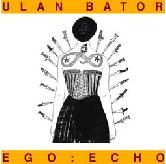 Ulan Bator is a French avante art rock trio who apparently take theirname from the capitol of Mongolia. "Ego : Echo" is their third albumand it was for the most part spontaneously created during 3 weeks ofsessions last summer in Florence, Italy with producer and Young GodRecords head Michael Gira (SWANS, The Angels of Light). Ulan are allabout tight and minimal, tense and repetitive guitar/bass/drum rockgrooves - both noisy and subdued - as musical and (French) vocalpassages become hypnotic head noddin' mantras. Add organ, piano, bow,keys, horn, tape loops, electronic drone, 'la la la' styled backingvocals and Gira's dry, crisp, clean and full production. Comparisonsto Can, Faust (Jean Herve Peron contributes horns to 1 song), the BadSeeds and Gira's own projects is inevitable as everything is sparseyet beautifully melodic and the sound and feel is similar, at the veryleast, in spirit. The 16 minute centerpiece "Let Go Ego" in particularprovides the variety of most everything Ulan Bator do in one song withextensive stretches of drone, somnambulant sonic meandering, heavy rockout and lengthy coda chant. "Ego : Echo" is a dynamic rock record thatresonates with passion and a sense of straightforward urgency. It'sone of a handful of cool musical things lately from France and it fitsright in with the rest of the Young God catalog. Up next from YGR arealbums by Calla and Flux Information Sciences in January and the newAngels of Light album "How I Loved You" in February.
Ulan Bator is a French avante art rock trio who apparently take theirname from the capitol of Mongolia. "Ego : Echo" is their third albumand it was for the most part spontaneously created during 3 weeks ofsessions last summer in Florence, Italy with producer and Young GodRecords head Michael Gira (SWANS, The Angels of Light). Ulan are allabout tight and minimal, tense and repetitive guitar/bass/drum rockgrooves - both noisy and subdued - as musical and (French) vocalpassages become hypnotic head noddin' mantras. Add organ, piano, bow,keys, horn, tape loops, electronic drone, 'la la la' styled backingvocals and Gira's dry, crisp, clean and full production. Comparisonsto Can, Faust (Jean Herve Peron contributes horns to 1 song), the BadSeeds and Gira's own projects is inevitable as everything is sparseyet beautifully melodic and the sound and feel is similar, at the veryleast, in spirit. The 16 minute centerpiece "Let Go Ego" in particularprovides the variety of most everything Ulan Bator do in one song withextensive stretches of drone, somnambulant sonic meandering, heavy rockout and lengthy coda chant. "Ego : Echo" is a dynamic rock record thatresonates with passion and a sense of straightforward urgency. It'sone of a handful of cool musical things lately from France and it fitsright in with the rest of the Young God catalog. Up next from YGR arealbums by Calla and Flux Information Sciences in January and the newAngels of Light album "How I Loved You" in February.samples:
Read More
- Administrator
- Albums and Singles
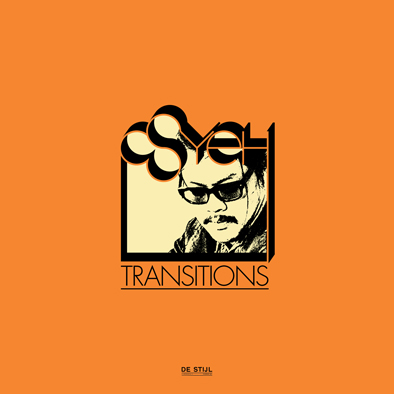 My appreciation of Spencer Yeh has increased in recent years due to his clear disinterest in re-covering familiar and expected territory.  Nowhere is that creative restlessness more conspicuously on display than here, an entire album of charmingly ramshackle left-field pop.  As it turns out, Yeh has been concealing a knack for songwriting all these years, as Transitions is a legitimately excellent and charismatic effort that makes me wish he had been doing this all along.  These are some of the most instantly likable songs that I have heard all year.
My appreciation of Spencer Yeh has increased in recent years due to his clear disinterest in re-covering familiar and expected territory.  Nowhere is that creative restlessness more conspicuously on display than here, an entire album of charmingly ramshackle left-field pop.  As it turns out, Yeh has been concealing a knack for songwriting all these years, as Transitions is a legitimately excellent and charismatic effort that makes me wish he had been doing this all along.  These are some of the most instantly likable songs that I have heard all year.
This, of course, is not Yeh's first foray into "pop," as that honor went to last year's "In the Blink of an Eye" 7" single.  Writing a great album is quite a bit different than recording a cool fluke single though and Yeh does not seem to have taken the challenge lightly...at least not from a craftsmanship angle.  In another sense, Spencer seems to have approached the album extremely lightly, which is exactly the right way to approach a pop album.  Transitions does not feel like any sort of calculated attempt to appeal to a wider audience; rather it feels like Spencer had an enormous amount of fun constructing short punchy songs packed full of meaty bass lines ("Transitions"), kitschy drum machine grooves (pretty much everything), and a host of amusing curve-balls like horns, wah-wah guitar, and crude 8-bit-sounding synth textures (ie- the killer, blurting breakdown in "Masculine Infinity").
Happily, Spencer's embrace of tunefulness and enthusiastic appropriation of New Wave-isms and burbling synths does not coincide with any sort of decrease in intelligence or any sidestepping of his more esoteric influences.  For example, the album's most overtly odd piece (the lurching, sing-song "Laugh Track") betrays a clear love of prog/art pop like Robert Wyatt and Slapp Happy.  Even more notable is the album's gleefully subversive synthpop closer "I Can Read Your Mind."  It is easily the album's most conventionally catchy and radio-friendly song, but it could not possibly be less commercial in origin as it is a actually a Father Yod and The Spirit of '76 cover.
There are a couple of slight wobbles in quality among these ten songs, like the guitar-centered power pop pastiches "The New Guy" and "Whose Life," but the album otherwise has the feel of a greatest hits album.  As bizarre as that sounds (particularly for a former noise musician), it is not hyperbole: nearly all of these songs sound like great, hook-heavy would-be singles that would make me exclaim "Woah- who is this?" if I heard them by chance on a college radio station or something.
Probably the highest compliment that I can pay Transitions is this: Yeh covers Stevie Nicks' "Rooms on Fire" and it turns out to be one of the album's weaker pieces.  While I am a closet Fleetwood Mac superfan, Yeh's original pieces are actually a lot more vibrant, quirky, and witty.  Of course, part of that might be because Yeh is a bit too reverent and serious in his treatment of the Nicks' piece, an error that he does rarely makes elsewhere  In fact, it is often pretty hard to tell when Yeh is being serious and sincere and when he is merely being hilariously deadpan, but his dry tone works much better in his own pieces because it is couched amidst livelier, more triumphantly absurd music.
Yeh has accomplished something truly unusual, as he has essentially made a weird, indulgent, and inventive pop album completely on his own terms that may perversely have widespread appeal.  Significantly, that is entirely due to Spencer's energy, sense of humor, and remarkably intuitive understanding of strong songcraft rather than any actual attempt to be liked outside the underground/avant-garde milieu.  I recognize that making a (mostly) synthpop album is an incredibly trendy thing to be doing right now, but there is a hell of a lot of playful self-sabotage and wrongness thrown into the mix to balance it out here.  To my ears, this is one of the most enjoyable and surprising albums to come out this year.
 
Read More
- Administrator
- Albums and Singles
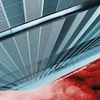 Sometimes, an artist sticks to a style even though they have done it to death but lack the vision to move on from the one idea that they briefly got right. Then there are artists who take this one idea and make it work, over and over again. A Place to Bury Strangers fall firmly into this second camp. They continue to sound as fresh as they did on their debut, which is impressive, considering the musical coffers of My Bloody Valentine and Jesus and Mary Chain should be well and truly bare by now. A Place to Bury Strangers have created a magnificent and charged work that demonstrates they have plenty of fire still to be unleashed.
Sometimes, an artist sticks to a style even though they have done it to death but lack the vision to move on from the one idea that they briefly got right. Then there are artists who take this one idea and make it work, over and over again. A Place to Bury Strangers fall firmly into this second camp. They continue to sound as fresh as they did on their debut, which is impressive, considering the musical coffers of My Bloody Valentine and Jesus and Mary Chain should be well and truly bare by now. A Place to Bury Strangers have created a magnificent and charged work that demonstrates they have plenty of fire still to be unleashed.
With the album's opener, "Alone," the group grabs hold of their distinctive overblown sound—where before it sounded like they could lose control at any moment—and focus it like a laser guided missile. While their ramshackle approach is what drew me initially to them on the first two albums, this tighter style of playing manages to channel all their best bits without losing any of the music’s power; "You Are the One" is the older, cooler brother of "Missing You" from their debut whereas "Mind Control" sees the group consolidate their strategic assault on my ears as they increase the intensity and volume significantly.
However, it is on the album’s title track where they show how much they have developed their sound in the last couple of years. It begins like an outtake from their first album before they completely blow the song open. Melodies, feedback and blissed out vocals all come together to make a perfect whole. It is a potent piece of psychedelic rock that sounds utterly timeless. This feeling permeates through the rest of Worship, particularly on the gorgeous, dream-like "Dissolved," where a gentle guitar refrain becomes buried in the sort of tremolo bar action that would send Kevin Shields into a swoon.
While I liked 2009’s Exploding Head, Worship sounds like the true successor to their first album and their incendiary live shows (my ears are still ringing from the last time I saw them). The more I listen to it, the more I fall in love with its beguiling distorted melodies. (You know a band has got you good when you wish you could jam along with them.) The only thing I feel is missing from this album is a strobe light to go with the sensory overload of the guitars. Other than that, it is impossible to find a flaw in Worship.
samples:
 
Read More
- Creaig Dunton
- Albums and Singles
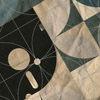
Originally an accompanying piece for the vinyl release of A Static Place, this afterward to that album utilizes the same archaic gramophones paired with computer processing approach, resulting in a similarly dynamic, understated piece of minimalist composition.
The WK in the title refers to Wilhelm Kempff, whose piano based recordings of Beethoven make up the original vinyl source material used to create this work.Opening with ringing, almost painfully shrill sounds, the dynamic nature of the piece become utterly apparent, as the pitch rises and falls, so does the volume, creating a constantly evolving, although distant and cold, piece of music.
The movement is slow throughout Coda's 20 minute duration, emphasizing mostly sustained and stretched out tones, and occasionally a bass-heavy rumble surfaces to act as a counterpoint to the otherwise bright sounds.The latter half especially is bathed in a gauzy, white noise glow that semi-obscures melodies below.Towards its end, the piece seems to take on a darker, bleaker hue before ending on the same type of clean and pure sounds that opened the disc.
While Coda is somewhat slow, its pacing works perfectly for its meditative, carefully unfolding sound.Moments may be somewhat disconnected or bleak, but never off-putting.Regardless of the mood conveyed, Mathieu's work always channels a complex beauty that may not always be delicate, but is always effective and compelling.
Read More
- Administrator
- Albums and Singles
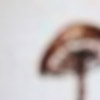 Initially a work inspired by Cage's 100th birthday this year, this album began life as a soundtrack to his One11 film. However as those recordings progressed, Australian composer Lawrence English began to develop a wider body of pieces that were inspired, both directly and indirectly, by the legendary artist, and take on a life of their own.
Initially a work inspired by Cage's 100th birthday this year, this album began life as a soundtrack to his One11 film. However as those recordings progressed, Australian composer Lawrence English began to develop a wider body of pieces that were inspired, both directly and indirectly, by the legendary artist, and take on a life of their own.
Cage’s use of chance, and his interest in Zen Buddhism are among the more often occurring themes and influences on these eight pieces, which are deliberate and meditative, but retain a loose, improvisational feeling at times.The ghostly wisps and sustained lower-frequency moments of "Otidea Onotica" possess a certain peaceful quality, though that is contrasted by the quickly rising and falling tonal outbursts around them.
"Gymnosporangium" and "Amanita Inaurata" also have this apparition-like sparseness, with the former especially employing the varying tones and pitches of "Otidea Onotica"."Hygrophorous Russula" takes a different path, sounding like a slow-motion fall accompanied with higher register textural passages.
The back to back pieces "Naematoloma Sublateritium" and "Coprinus Comatus" make for an especially overt contrast, with the former relying on almost foghorn like dark sounds that go to a distinctly creepy, dark place, while the latter has a warmer, inviting character to it, even if they follow similar structures compositionally.
Closer "Entoloma Aborivum" stands out as perhaps the most drastically different piece on this album, given its harsher, more commanding tone.Even though it moves at a glacial pace, the heavily reverberated textures, at times resembling elongated guitar noise, are harsher and more commanding than what preceded it.The closing moments also have a shrill, feedback like quality that adds a bit of welcome abrasion to an otherwise gentle work.
For/Not For John Cage may show differing levels of inspiration courtesy of the legendary composer, but English's work also stands on its own as the work of a powerful, established artist in his own right.At times ascetically sparse, other times boisterous and dominating, there is a significant amount of variation within these eight pieces, but they all sit nicely beside one another as a coherent work.
samples:
 
Read More
- Administrator
- Albums and Singles
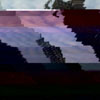 Locrian has spent the better part of the last four years distinguishing themselves from the also-rans of the post-Sunn O))) drone scene, crafting their own distinct sound and identity amid many less engaging acts. While much of their recent work has been focused on the deconstruction of metal symbolism, paired with a more conventional rock bent, here the trio go back to their dissonant, abstract roots, with help from legendary audio and visual artist Christoph Heemann.
Locrian has spent the better part of the last four years distinguishing themselves from the also-rans of the post-Sunn O))) drone scene, crafting their own distinct sound and identity amid many less engaging acts. While much of their recent work has been focused on the deconstruction of metal symbolism, paired with a more conventional rock bent, here the trio go back to their dissonant, abstract roots, with help from legendary audio and visual artist Christoph Heemann.
On their most recent albums and collaborations, the trio of Terence Hannum, Andre Foisy and Steven Hess demonstrated a distinct turn in shaping the heavily treated synths and rapid guitar work into more traditionally song-like structures, without ever fully embracing conventionality.Here that is not quite as much of a noticeable feature, with the album divided into four 11 to 15 minute tracks that lead to longer, more experimental compositions.
Even the artwork shows some variance from the norm:the band’s penchant for using the signifiers of metal are all but gone, replaced by what more closely resembles a corrupted jpeg file.The sound, however, is clearly the work of Locrian, though the contributions from Heemann expand on their shared themes and approaches to sound.
"Hecatomb" is perhaps the most familiar sounding. The drums are notable but low in the mix, with electronic loops and acoustic guitar strums almost giving a Morricone like soundtrack vibe to the sound.The layers are piled on, each one more complex and intertwined with the one before, all the while generating an almost imperceptible melody hidden in the detritus.Eventually it focuses on the droning guitars and keyboards, feeling more in league with the earlier, more abstract Locrian works.
One characteristic Locrian has never traded in is the intentional, and usually overwrought, "evil" sound that other artists have embraced.Which is, I have always felt, a good idea.It helped them to develop their own identity without letting cliché overshadow content.However, on "Loath the Light," there is a horrifying sensibility via the crashing cymbals and bent synths, magnified by Hannum's tortured, guttural screams.Do not be mistaken: this does not come across as pseudo demonic high school metal bullshit.This is much more in league with Nature Unveiled/Dogs Blood Rising era Current 93, a hallmark of terrifying recordings, and transcends any corniness usually associated with such approaches.
The second half of the album is less visceral and more reflective, such as the layered guitar and propulsive low-end parts of "Edgeless City," which is by no means a lighter piece, but just feels dark, rather than overtly malignant."The Drowned Forest" takes on a more monastic feeling, with chanted vocals starting out as the focus, with a subtle amount of musical accompaniment that eventually peaks into a complicated wall of sound.There is no sense of movement or propulsion to be heard, it instead makes for a slowly decaying piece that just looms imposingly.
It is hard to tell where the separations are between Locrian's and Heemann's contributions, and that is one of the hallmarks of an effective collaboration.Neither artist seems to overshadow the other, but both retain their own identities perfectly, with Heemann's gloriously concrete tones and post-industrial chaos matching with Locrian's metal tinged guitar and electronic layers.Both artists step a bit out of their comfort zones on this album, and the result is a glorious success.
samples:
 
Read More


